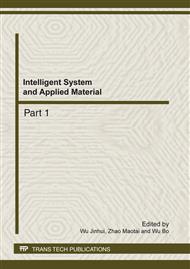[1]
Friess W. Collagen–biomaterial for drug delivery. European Journal of Pharmaceutics and Biopharmaceutics. Vol. 45(2), pp.113-136, (1998).
Google Scholar
[2]
Chevallay B, Herbage D. Collagen-based biomaterials as 3D scaffold for cell cultures: applications for tissue engineering and gene therapy. Medical and Biological Engineering and Computing. Vol. 38(2), pp.211-218, (2000).
DOI: 10.1007/bf02344779
Google Scholar
[3]
Helseth DL, Veis A. Collagen self-assembly in vitro. J. Biol. Chem. Vol. 256, pp.7118-7128, (1981).
Google Scholar
[4]
Gillette BM, Jensen JA, Tang B, Yang GJ, Bazargan-Lari A, Zhong M, et al. In situ collagen assembly for integrating microfabricated three-dimensional cell-seeded matrices. Nature Materials. Vol. 7(8), pp.636-640, (2008).
DOI: 10.1038/nmat2203
Google Scholar
[5]
Anfinsen CB. Principles that govern the folding of protein chains. Science. Vol. 181(96), pp.223-230, (1973).
DOI: 10.1126/science.181.4096.223
Google Scholar
[6]
Fengzhi Jiang, Heinrich Hörber, Jonathon Howard, et al. Assembly of collagen into microribbons: effects of pH and electrolytes. Journal of Structural Biology. Vol. 148, p.268–278, (2004).
DOI: 10.1016/j.jsb.2004.07.001
Google Scholar
[7]
Tokiwa Y, Jarerat A. Biodegradation of poly (l-lactide). Biotechnology Letters. Vol. 26(10), pp.771-777, (2004).
DOI: 10.1023/b:bile.0000025927.31028.e3
Google Scholar
[8]
M. F. Paige, J. K. Rainey, M.C. Goh. A study of fibrous long spacing collagen ultrastructure and assembly by atomic force microscopy. Micron. Vol. 32, p.341–353, (2001).
DOI: 10.1016/s0968-4328(00)00037-8
Google Scholar
[9]
M. C. Goh, M. F. Paige, M. A. Gale, et al. Fibril formation in collagen. Physica A. Vol. 239, pp.95-102, (1997).
Google Scholar
[10]
Akira Tasaki, Naoki Yamanaka, Makoto Kubo, et al. Three-dimensional two-layer collagen matrix gel culture model for evaluating complex biological functions of monocyte-derived dendritic cells. Journal of Immunological Methods. Vol. 287, pp.79-90 (2004).
DOI: 10.1016/j.jim.2004.01.014
Google Scholar
[11]
Tatiana Segura, Peter H. Chung, Lonnie D. Shea. DNA delivery from hyaluronic acid-collagen hydrogels via a substrate-mediated approach. Biomaterials. Vol. 2, pp.1575-1584, (2005).
DOI: 10.1016/j.biomaterials.2004.05.007
Google Scholar
[12]
Laurent Galois, Sandrine Hutasse, Delphine Cortial, et al. Bovine chondrocyte behaviour in three-dimensional type I collagen gel in terms of gel contraction, proliferation and gene expression. Biomaterials. Vol. 27, p.79–90, (2006).
DOI: 10.1016/j.biomaterials.2005.05.098
Google Scholar
[13]
Robert B. Vernona, Michel D. Gooden, Stephanie L. Lara, Thomas N. Wight. Native fibrillar collagen membranes of micron-scale and submicron thicknesses for cell support and perfusion. Biomaterials. Vol. 26, p.1109–1117, (2005).
DOI: 10.1016/j.biomaterials.2004.04.019
Google Scholar
[14]
Robert B. Vernona, Michel D. Gooden, Stephanie L. Lara, et al. Microgrooved fibrillar collagen membranes as scaffolds for cell support and alignment. Biomaterials. Vol. 26, p.3131–3140, (2005).
DOI: 10.1016/j.biomaterials.2004.08.011
Google Scholar
[15]
Yanhui Li, Yudong Huang. Preparation of Collagen-Polyurethane Composite Film and Its Subcutaneous Implantation in Rats: The Improvement of Tissue Compatibility. Journal of Applied Polymer Science. Vol. 99(4), pp.1832-1841, (2006).
DOI: 10.1002/app.22150
Google Scholar


